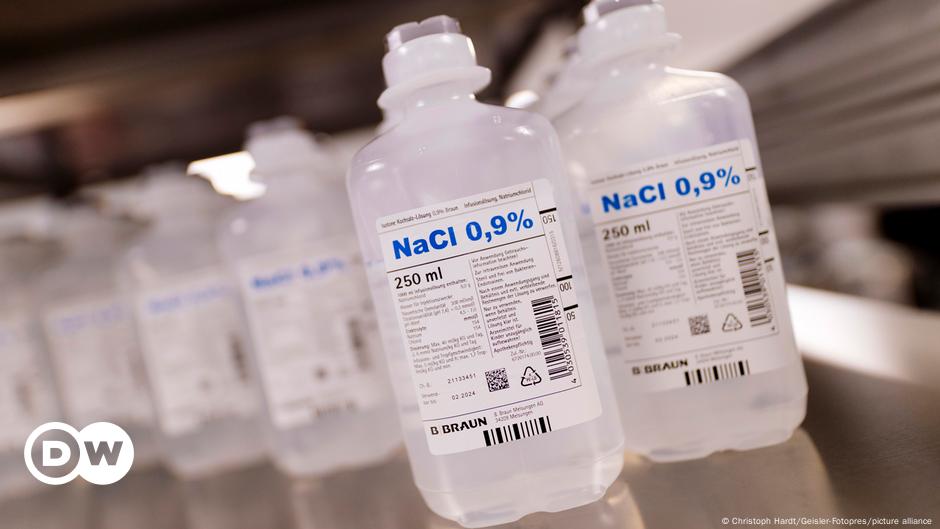It costs just a few cents, but it’s currently in short supply. Saline solution is a scarce commodity in German hospitals and pharmacies, but is urgently needed for surgeries, irrigation and intravenous procedures. According to Thomas Preis, director of the North Rhine Chamber of Pharmacists, the situation has worsened dramatically in recent months.
“What has already been a major problem in hospitals for months is now also affecting outpatient care,” he warned the Düsseldorf-based newspaper. line post.
North Rhine-Westphalia’s Ministry of Health admitted there was a supply bottleneck. For several months, “clinics in North Rhine-Westphalia and Germany were only able to accommodate 80% of the need,” the report said, but the number has recently fallen to around 50%. According to the Federal Institute for Medicines and Medical Devices (BfArM), this situation will continue in the coming months.
In particular, there is a shortage of antibiotics.
Germany has been repeatedly affected in recent years by shortages of medicines, particularly antibiotics and pediatric medicines. The impact is serious: a survey of members of the German Pediatric Association (BVKJ) found that in spring 2024, approximately one-third believe the quality of care is at risk.
The study also found that treatment is taking longer because doctors have to check in advance what drugs are available. According to the German Pharmacists’ Association (DAV), around 500 prescription drugs are already causing problems.
Other EU countries are also affected by supply shortages. According to a 2023 study conducted by the Pharmaceutical Group of the European Union (PGEU).The situation is worsening in several member states, including Sweden, Portugal and Spain.
Active ingredients from China and India
As with pharmaceutical manufacturing, the causes of shortages are complex. Home to major pharmaceutical companies such as Bayer, BASF, Boehringer Ingelheim and BioNTech, Germany was once considered the ‘pharmacy of the world’, but now manufacturing occurs all over the world. Supply chains are longer and more prone to disruption.
Currently, the majority of active ingredients are produced in China and India. Not only are wages lower there, but environmental regulations are also weaker than in the EU. The focus is on mass production and monopoly to make medicines cheaper. As a result, fewer suppliers are producing more products than ever before.
Professor David Frankas, supply chain expert at Worms University of Applied Sciences, said: “Where there used to be 10 suppliers of fever paracetamol syrup, there is now only one major supplier left.” I explained to DW.
Professor Ulrike Holzgrabe, an expert in pharmaceutical and medicinal chemistry at the University of Würzburg, said: “We are therefore dependent on just a few manufacturers. And if one of them gets stuck, the whole supply chain gets stuck.” says.
“If there is a small disaster in the supply route, such as the closure of Shanghai ports or ships blocking the Suez Canal due to the COVID-19 pandemic, the goods will not reach us,” she said. He told DW.
Just-in-time production is useless
Limited inventory and just-in-time production will only exacerbate the problem if temporary shortages in the production chain cannot be compensated for. But experts believe restocking will be costly. Storage facilities are expensive, and you never know if the stored drug will actually be sold.
Demand fluctuations are very large, for example, during the COVID-19 pandemic, demand for infection farms collapsed as widespread mask-wearing led to a sharp decline in several other infectious diseases. . The company couldn’t sell expensive antibiotic juice for children and had to throw it away. Two years later, demand skyrocketed again.
Price issues are particularly acute for generic drugs, which account for 70-80% of the basic supply of drugs. “The manufacturing margins for such products are very low,” Holzgraab said. Manufacturers are forced to produce as cheaply as possible due to discount agreements and other agreements introduced into Germany’s healthcare system years ago.
There are many calls for this, but it will be difficult to bring production completely back to the EU. One reason for this is the complexity of manufacturing the fine chemicals needed for the active ingredients. “We have enacted environmental laws that make this almost impossible,” Holzgrave said.
Even if that were possible, it wouldn’t be a solution for this winter. “It will take at least five years to rebuild the production facility,” Francas said.
This article has been translated from German.

